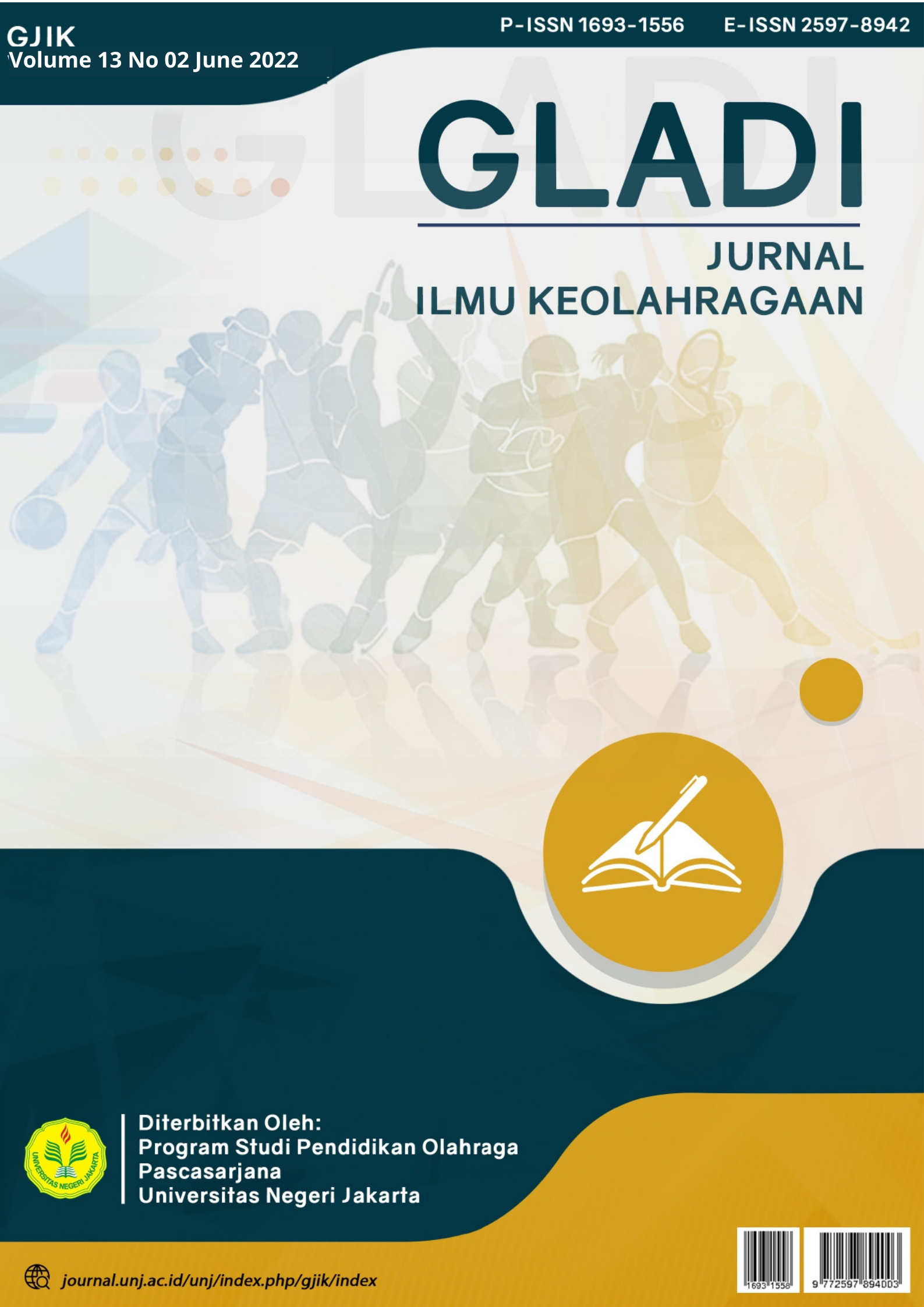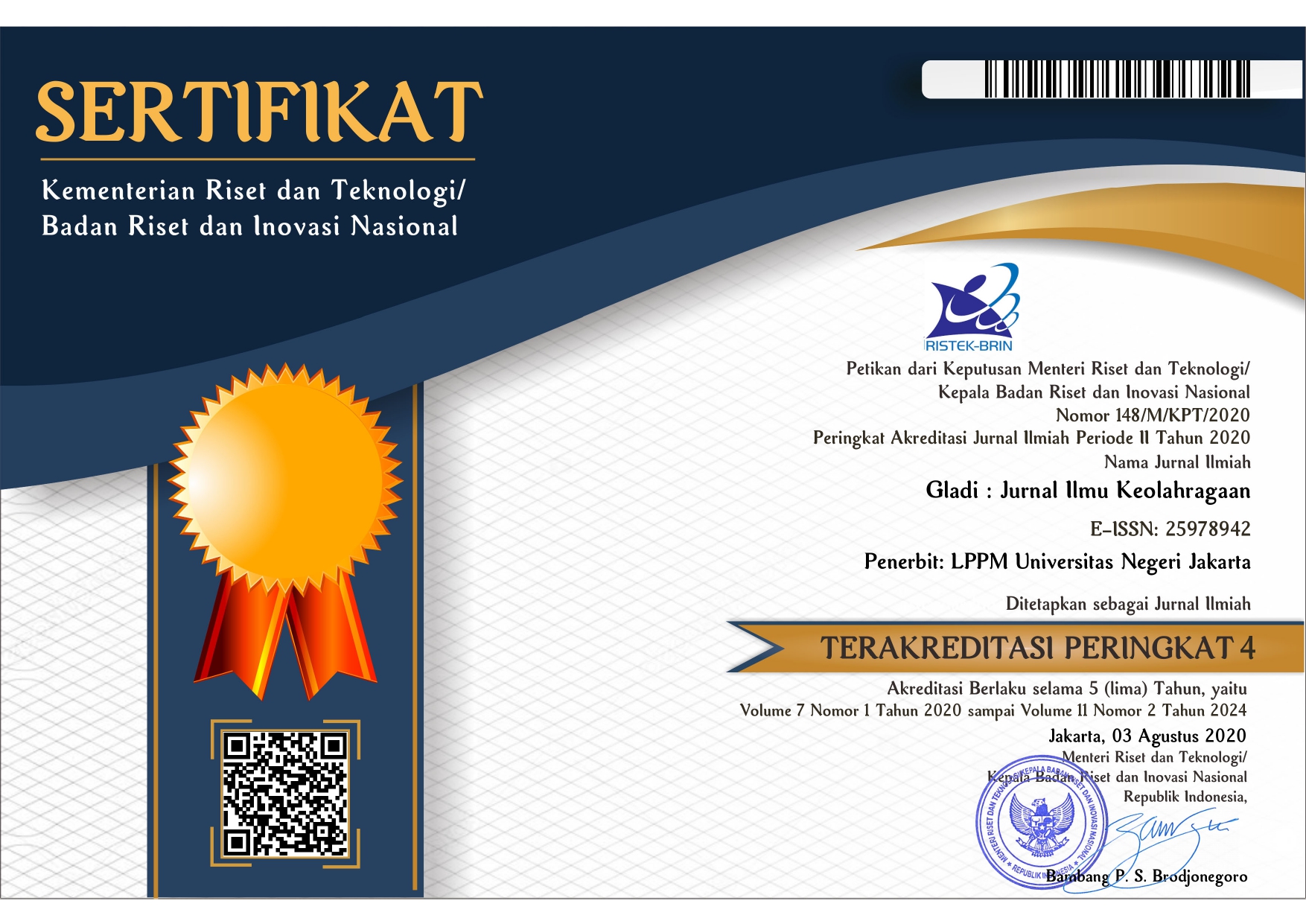The result of physical fitness learning in sman 36 jakarta during the covid-19 pandemic
Keywords:
Keywords: learning methods; project; recitation; motivation; physical fitnessAbstract
Inappropriate learning methods and low learning motivation of students will have an impact on physical fitness learning outcomes. The purpose of this study was to obtain a more complete picture of the influence of learning methods and learning motivation on Physical Education Learning Outcomes.The research method is an experiment with a treatment by level 2x2 design. The research sample is 160 students of class XII. Hypothesis testing using the Tukey test. Based on the results of the study, it can be concluded: 1) there is a significant difference in the effect between methods A1 and A2 on Y. This is evidenced by the value of Fcount = 20.20 > Ftable = 3.90. 2) There is a significant interaction effect between A and B on Y. The results are significant, because Fcount = 84.64 > Ftable = 3.90. 3) there is a significant difference in Y using A1 and A2 in group B1. This is evidenced by the value of Qcount = 12.78 > Qtable = 3.79. 4) there is a significant difference in Y results using the A1 and A2 learning methods in group B2. It is proven by the value of Qcount = 3.98 > Qtable = 3.79.
Downloads
References
Achmad, N. K., & Sriekaningsih, A. (2018). Effect of Mutation and Career Development on Performance through Work Motivation at the Class I Airport of Juwata Tarakan. Journal Research and Economy, 2(3), 27–39.
Adi, S. (2014). Evaluasi Pembelajaran di Sekolah. Jakarta: Universitas Terbuka.
Alruwaih, M. E. (2015). Effect Of Blended Learning On Student ’ S Satisfaction For Students Of The Public Authority For Applied Education And Training In Kuwait. Science, Movement and Health, XV(2), 442–448.
Amalia, M., Budiyono, & Kurniawan, H. (2019). Hubungan Kecerdasan Interpersonal dan Motivasi Belajar terhadap Hasil Belajar Matematika. PRISMA, Prosiding Seminar Nasional Matematika, 2.
Arifin, Z. (2016). Model-Model Evaluasi Program. Jurusan Kurikulum dan Teknologi Pendidikan. Ilmu Pendidikan. Depok: PT raja grafindo.
Barkah, A., Mardiana, T., & Japar, M. (2020). Analisis Implementasi Metode Pembelajaran Dalam Masa Pandemi Covid-19 Pada Mata Pelajaran Pkn. Pedagogi: Jurnal Penelitian …, 7(November), 123–136. https://doi.org/10.25134/pedagogi.v7i2.3426.Diajukan
Fikri, A. (2017). Meningkatkan Kebugaran Jasmani Melalui Metode Latihan Sirkuit Dalam Pembelajaran Pendidikan Jasmani Olahraga Dan Kesehatan Di Sma Negeri 1 Lubuklinggau. Jurnal Pembelajaran Olahraga, 3(1), 90–102.
Hendri,Gus.Aziz, I. (2020). Motivasi siswa dalam proses pembelajaran pendidikan jasmani olahraga kesehatan 1,2. Patriot, 2, 171–181.
Hermanto, H. (2020). Hambatan Pembelajaran Penjas di Masa Covid-19, (20), 95605611.
Jeffrey, L. M., Milne, J., Suddaby, G., & Higgins, A. (2014). Blended Learning : How Teachers Balance the Blend of Online and Classroom Components. Journal of Information Technology Education: Research, 13, 121–140.
Jeong, H. C., & So, W. Y. (2020). Difficulties of online physical education classes in middle and high school and an efficient operation plan to address them. International Journal of Environmental Research and Public Health, 17(19), 1–13. https://doi.org/10.3390/ijerph17197279
Kaufman, K. A., Glass, C. R., & Arnkoff, D. B. (2014). Evaluation of mindful sport performance enhancement (MSPE): A new approach to promote flow in athletes. Journal of Clinical Sport Psychology, 3(4), 334–356. https://doi.org/10.1123/jcsp.3.4.334
Komarudin, & Prabowo, M. (2020). Persepsi Siswa Terhadap Pembelajaran Daring Mata Pelajaran Pendidikan Jasmani Olahraga Dan Kesehatan Pada Masa Pandemi Covid-19. Majalah Ilmiah Olahraga (MAJORA), 26(2), 56–66.
Kusuma, B. A., & Setyawati, H. (2016). Survei Faktor-Faktor yang Mempengaruhi Minat Olahraga Rekreasi Akhir Pekan di Alun-Alun Wonosobo. Journal of Physical Education, Sport, Health and Recreations, 5(2), 68–73.
Kusuma, M. W. K., Jampel, I. N., & Bayu, G. W. (2019). Pengaruh Metode Pembelajaran Matematika Gasing Terhadap Hasil Belajar Matematika. Jurnal Pedagogi Dan Pembelajaran, 1(1), 37. https://doi.org/10.23887/jp2.v1i1.19330
Maksum, T. C. M. and A. (2012). Sport Development Index, Alternatif Baru Mengukur, Kemajuan Pembangunan Bidang Keolahragaan,Konsep,Metodologi dan Aplikasi,. Jakarta: Indeks.
Mayanto, A., Zulfikar, Z., & Faisal, A. (2020). Pengaruh Metode Pembelajaran Dan Gaya Kognitif Terhadap Motivasi Dan Hasil Belajar Penjas. Jurnal Ilmiah KONTEKSTUAL, 2(01), 69–78. https://doi.org/10.46772/kontekstual.v2i01.251
Novitaria, I. (2017). The Role of Public Relations In Sport Organization In Indonesia. American Scientific Publishers Advanced Science Letters, 23(January), 528–531.
Novitaria, I., Ari, M., & Adi, S. (2020). The Use of Computer Mediated Communication ( CMC ) in Distance Learning During Covid-19 Pandemic : Pros and Cons. Nternational Conference on Social and Political Sciences, 510(Icosaps), 95–102.
Pingge, H. D. (2015). Faktor Yang Mempengaruhi Hasil Belajar Siswa Sekolah Dasar Di Kecamatan Kota Tambolaka. Jurnal Pendidikan Sekolah Dasa, 3(4), 23–31.
Rangga, Y. (2013). Perbandingan Tingkat Kebugaran Jasmani Siswa Kelas IX Rintisan Sekolah Berstandar Internasional SMP 1 Kawedan dan Siswa Kelas IX Sekolah Standar Nasional SMP 2 Kabupaten Magetan Pada Tahun 2013. Jurnal Penelitian Surabaya, 5(7), 113–125.
Ronnlund, M. (2014). Justice in and Through Education? Students’ Participation in Decision ‐ Making. Academic Journal Interdisiplinary Studies, 13(2), 104–113. https://doi.org/10.2390/jsse
Sofyana, L., & Rozaq, A. (2019). Pembelajaran Daring Kombinasi Berbasis Whatsapp Pada Kelas Karyawan Prodi Teknik Informatika Universitas Pgri Madiun. Jurnal Nasional Pendidikan Teknik Informatika, 8(1), 81–86.
Utomo, M. A. S., Muhyi, M., & Wiyarno, Y. (2020). Pengembangan Modifikasi Media Pembelajaran untuk Meningkatkan Kebugaran Jasmani Siswa Sekolah Dasar. Jurnal Pendidikan Kesehatan Rekreasi, 6(1), 56–73.
Whipp, P. R., Jackson, B., Dimmock, J. A., & Soh, J. (2015). The effects of formalized and trained non-reciprocal peer teaching on psychosocial, behavioral, pedagogical, and motor learning outcomes in physical education. Frontiers in Psychology, 6(FEB), 1–13. https://doi.org/10.3389/fpsyg.2015.00149
Zuhro, C. (2016). Pengaruh Sikap, Motivasi Dan Metode Mengajar Terhadap Hasil Belajar Mahasiswa Pada Mkdu Bahasa Inggris Di Politeknik Negeri Jember. Jurnal Ilmiah Inovasi, 16(1), 75–83. https://doi.org/10.25047/jii.v16i1.7







